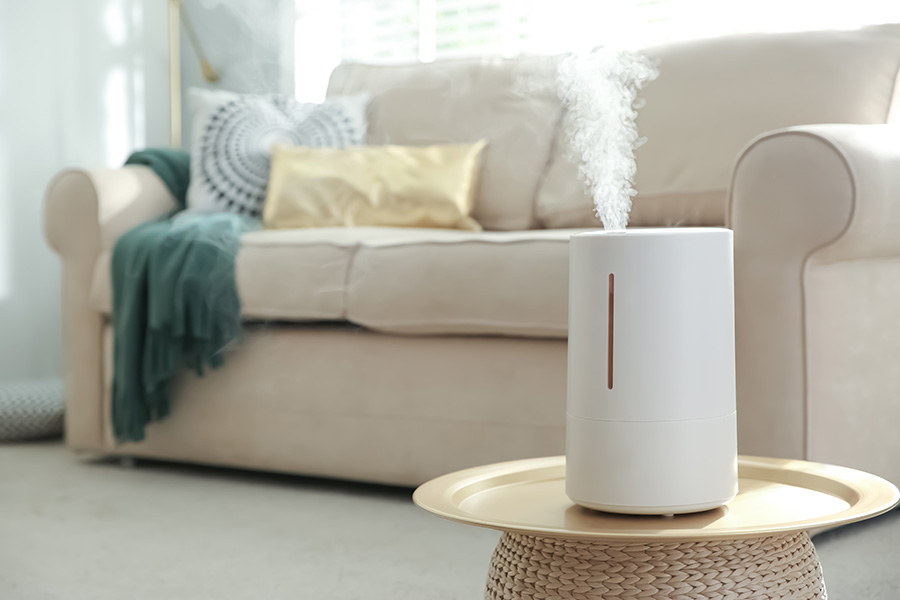
Service
The warm days and long nights are finally here! Summertime in Montana is a special time, and it can also get pretty dry as the temperatures rise. Here at Mountain Heating & Cooling we want to help keep your home as comfortable as possible through the dry summer months. A whole home humidifier can be a great option for your home’s air, and we’re here to help you choose the right model for your space.
What is a Whole Home Humidifier?
A humidifier puts moisture into the air in your home. This can be really helpful in the winter, when the weather and heating systems in the home can make the air dry. It can also be a huge help in places where the climate is dry, like in Montana, in the summer months. Dry air in the home can dry out skin, lips, and even your houseplants. This is where a humidifier comes in!
What are Humidifiers Good For?
- Helping with Dry Skin and Lips: Dry air is notorious for dry and chapped skin and lips. We all know how uncomfortable this can be, and when it’s dry in your home, lotion and chapstick can struggle to keep up. Getting more moisture into the home’s air helps your skin and lips to absorb it. A humidifier (along with creams and topical options) can also help sufferers of skin conditions like Eczema retain moisture, reduce itching, and prevent uneasy sleep from irritation.
- Extending the Life of Home Furnishings: Moisture from a humidifier can be really helpful around the home. Wood floors or furniture may last longer, and humidity can help to prevent wallpaper and paint from cracking. Expensive textured paint jobs could last a lot longer if you add some moisture in the air when it gets dry.
- Preventing the Spread of Colds and Flu: Humidifiers can help prevent you from getting sick by adding moisture to the air. This is because many viruses survive better in drier conditions. Higher humidity gives viruses a better chance of attaching to water vapor droplets and falling out of the air, instead of clinging to us and infecting us directly.
- Vibrant House Plants: Lots of the indoor houseplants we know and love are tropical and thrive in humidity. Many plants will be unhappy if it gets too dry, and keeping a good level of humidity can keep plants happy and thriving.
Humidifiers We Carry at Mountain Heating & Cooling
If you’re looking for a humidifier for your home, there are options, and we’re here to help you find the best fit for your needs.
- Honeywell ByPass Humidifier: The Honeywell model is a whole house steam humidifier that is effective and simple, so you can get whole home humidification without it costing the earth. A bypass humidifier has a bypass duct that makes use of the furnace’s own fan to recirculate warm air across a humidifier pad and back into the ductwork.
- Trane Steam Humidifier: Steam modifiers inject steam into the air stream and spread mist into the air to reduce dryness. Steam humidifiers offer a more efficient method of releasing humidity into the home.
It can feel daunting to choose the right humidifier for your space, and to know how to install and properly maintain it to get the most out of it. We’ve got you covered. At Mountain Heating & Cooling we take the time to get to know your space and your needs, and to make sure we fit the right whole home humidifier to your space. Contact us to arrange an appointment today.
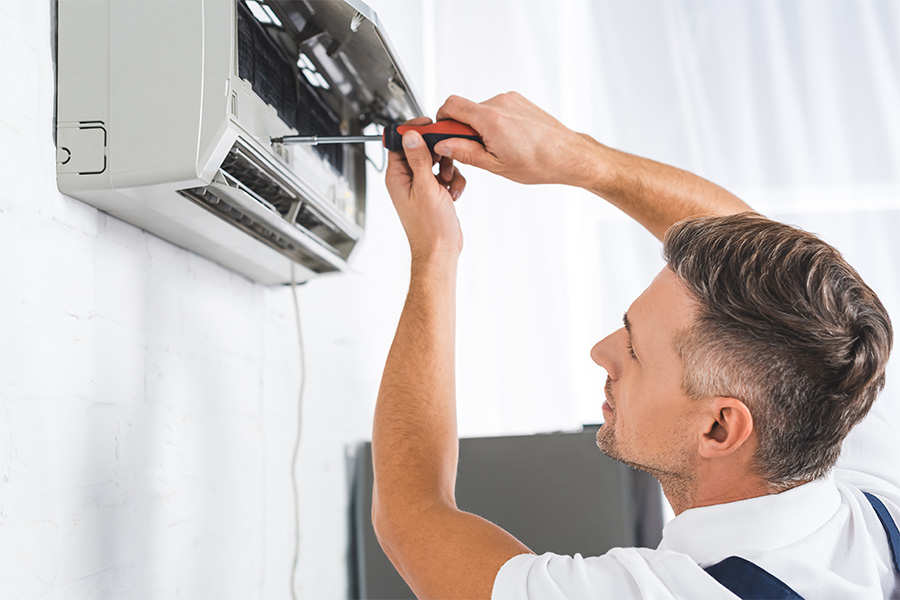
Service
There’s nothing better than coming home to a nice, cool house on a hot summer’s day. Getting the right air conditioner for the summer so that your house stays perfectly cool is a game-changer. There are a lot of options for air conditioners now with the technologies changing and advancing quickly. It’s important to consider all of your options for your space before you make a decision.
Take the time to understand your needs
Before you can find the perfect air conditioner for your home, you’ll want to think about what your needs look like. For example, consider:
- How large the space is you want to be cooled
- Whether you have hot or cold spots in your home
- How many people live in your home, and whether you have pets
- If anyone in your home suffers from allergies or asthma, and if you’re concerned about indoor air quality
One of the biggest factors is the size of your space. If a unit is oversized you’ll waste unnecessary power, increasing power bills, and have the possibility of your coil freezing. An undersized AC unit will not cool your space, even when it is firing at 100%. Talk to a comfort specialist about the right size of unit for your home and have them calculate your cooling load.
Know when and why it’s time to get a new air conditioning unit
If you don’t already have central air or an air conditioning unit, now is a perfect time to invest and to get your home ready for the summer months. Summer rolls around quickly and hotter months are coming. AC can help make your home comfortable.
As a general rule, if you already have an air conditioner and it is 10 years old or more now is the time to look into replacing it. You could save up to 40% on your cooling energy costs by replacing it with a newer, more efficient model. Technologies are advancing, and the newer models are much more efficient and have more options than the older models do. When it comes to replacing, it pays to speak to an expert to find out what would be the best fit for your home.
Consider the different types of air conditioning units
There are lots of different types of air conditioners you can get, three of the main types that we offer are:
- Mitsubishi Ductless AC— These are ductless mini-split air conditioners and heaters. They consist of indoor units connected to an outdoor compressor. Coolant passes between the units, carrying the heat from indoors to the outdoor unit where it is released.
Pros: No ductwork or floor vents are needed, making them less visible in your home. They are usually a great choice for smaller homes or problem spaces, since less cooling power is needed. They’re also are more efficient than window units.
Drawbacks: One thing to keep in mind is that they can also be more expensive to install than other units, and are zoned for each room, rather than a whole house.
- Heat Pump— A heat pump uses the outside air to both heat and cool a home. It is the most economic and efficient way to heat a home most of the time.
Pros: While an air conditioner only cools the air, heat pumps can heat or cool thanks to a reversing valve in the outdoor unit that transfers heat into your home.
Drawbacks: A big drawback to a heat pump is that it can be limited in their ability to heat when the temps drop below 20 degrees. Our customers often supplement heat pumps with a furnace or electric baseboard heat for the colder days.
- Central AC— With a central air system, cool air is sent through the air handler on your furnace into air ducts, where it is carried into the rest of the house.
Pros: If you have ductwork in your home already, it will often be more cost-effective to stay with a central system and cool your whole home. If your home is larger, a central air system may also be the better choice since the greater power of a central air system will pay off for a larger space.
Drawbacks: A drawback of central air units are more they require ducting, so if you don’t have a crawl space or open attic etc for ducts adding them can be a big project.
It can feel overwhelming to weigh up the different types, models, and specs, and then figure out which is right for your home. That’s where speaking to a trusted expert with years of experience can really help. At Mountain Heating & Cooling we take the time to get to know your space and your needs, and to make sure we fit the right system and model to your home
Give us a call to arrange an appointment today.
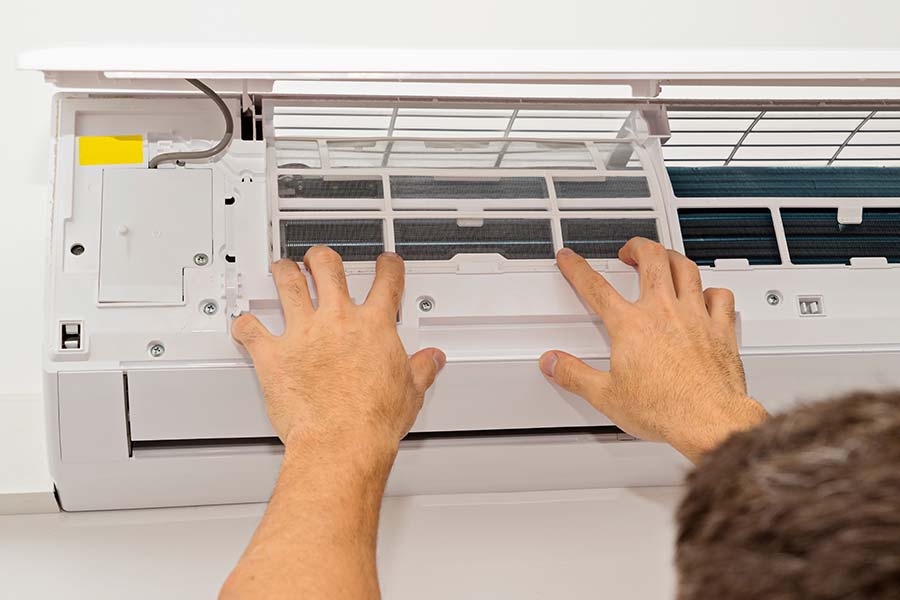
Service
The long Montana winter is almost over and we’re all looking forward to long, sunny days, and spending more time outside with family. As we get ready for the warmer months, let’s make sure your home is ready for the changing seasons and the unpredictable Montana weather we all know and love. AC repair when the summer months kick in is probably the last thing you want to worry about. To help prevent that we’ve rustled together some top tips for you all:
Dirt and neglect are the top causes of cooling system inefficiency and problems. To make sure your air conditioning unit is working smoothly, you’ll want to make sure routine maintenance and any necessary AC repairs are done before summer rolls around. The last thing you want to deal with on a hot summer’s day is unhealthy air in your home, an unexpectedly high utility bill, or—last but not least—the unit failing and turning off altogether.
Folks are often shocked to find out that the air in their homes can be much more polluted than the air outside—especially when we live in Montana and are surrounded by fresh mountain air. Getting your air filter changed helps make sure the air in your home stays as clean and healthy as outside. This is especially important this year since we’ve all spent so much more time at home, making it easier for dirt, dust, and dander to build up in your air system. Let’s keep your home’s air clean and fresh as we roll into summer!
3. Check your air ducts
Houses that use ducts to push conditioned air throughout the house are excellent, and especially in the heat of summer. That being said, about 20% of the air that moves through the duct system in your house is lost due to poorly connected ducts, leaks, and holes. This can ramp up your utility bill and decrease your system’s life expectancy. A couple of things to consider:
- Getting the ducts properly sealed can be a game-changer for keeping your home’s air fresh (and keeping those utility bills down!).
- It can also be worth getting your air ducts cleaned. Over time, a sticky residue can form in them from things like dirt and pollen. We generally recommend getting them cleaned every 3-5 years, depending on things like system use and pets, and we’re always happy to take a look at your system to see what needs doing.
4. Get your irrigation system running again
Summer can be dry around here, and we all want to make sure our yards are a great place to spend time outside. Part of that is having a reliable, well-functioning irrigation system to keep your landscape green and vibrant. Taking the time to carefully get your irrigation system going after the freezing cold months helps keep it performing well year after year. You’ll want to go carefully and make sure you take steps like checking the soil isn’t frozen, testing the water pressure, and gently refilling the system. If you’re not feeling confident about the start-up procedure, call in an expert to help.
Having clean air in your home in the summer is so important, and so is knowing that your systems are running well and you aren’t overpaying for your bills. Let’s make sure your AC is blowing ice-cold, fresh air on those hot summer nights!
Schedule a summer maintenance consultation or AC repair today.
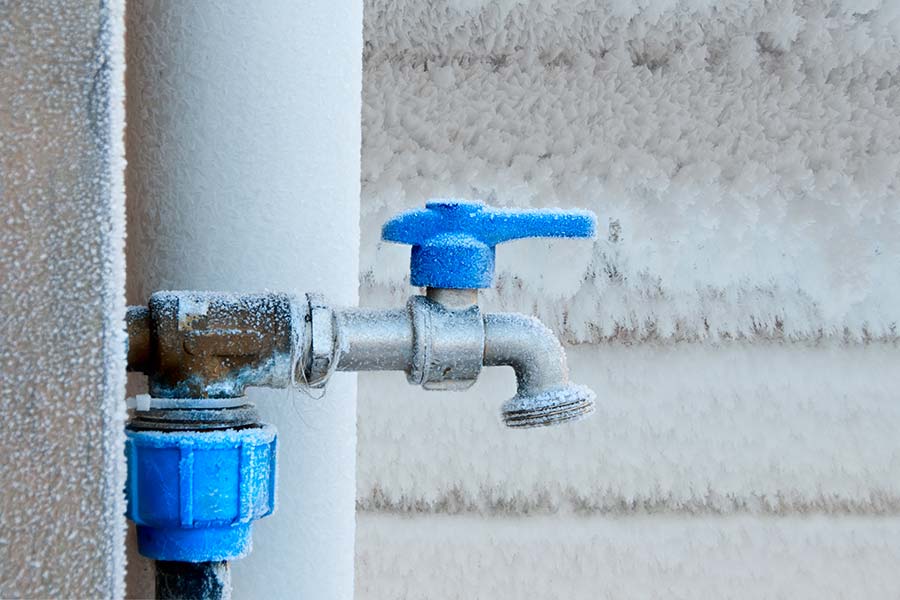
Service
We’re in the thick of winter here in Montana and that means we have a few months left of fluctuating temperatures and cold nights. With everything that’s been going on in the world, the last thing any of us want to deal with right now is frozen pipes. At best a frozen pipe means no water while it thaws, and at worst it means a cracked pipe, flooding, or plumbing damage. Read on to find out what it takes to prevent your pipes from freezing this winter.
One question we get from folks a lot in the wintertime is “how can I stop my pipes from freezing?”, and especially if their home (and plumbing) are a little older. Here are a few tips from our master plumbers:
Protect your pipes to prevent freezing before it gets cold
First off, let’s make sure your pipes are protected before the cold temps roll in. Wind chill and low temperatures can both lead to frozen pipes, and in Montana, we’re no strangers to either. Here are a few tips:
- Insulate your pipes properly – You’ll want to make sure pipes in the attic and crawl spaces are fully protected with insulation. You can also use heat tape on the pipes.
- Make sure your pipes are sealed – Fully sealed pipes are better equipped to deal with the cold temps. Take extra care of places where the pipes run from outside to inside, and be sure to seal or caulk any cracks.
- Check your outdoor pipes – Make sure any outdoor faucets are drained and turned off, and be sure to disconnect garden hoses and blow out your sprinklers before the cold sets in.
When it gets cold
Now that winter’s here, let’s make sure those really cold temperatures don’t cause your pipes to freeze or burst. As a rule of thumb, pipes can start to freeze when the temperature reaches around 20 degrees Fahrenheit, so if you see temps getting close to that in the forecast it’s time to get prepared.
- When you see a big temperature drop, start a slow drip of water in all of your faucets. Make sure you have a cold and a hot water drip.
- Consider shutting the water supply off to faucets and appliances— like the washing machine— in unheated interior areas like the basement or the garage. Up to 37% of all frozen pipes occur in basements, and this can happen even if the pipes thread through cabinets so it’s worth being careful.
- If you’re heading out of town for a few days see if a trusted neighbor, friend, or family member can check to make sure steps are being taken to prevent pipes from freezing.
If you think your pipes have frozen
It happens, and especially in the harsh Montana winters. Here’s what you can do:
- Turn on the faucet. If the water trickles or doesn’t run at all, the pipe could be frozen.
- Check the water line and look for any breaks or cracks.
- If you find any breaks or notice flooding, turn off the main water supply and call an emergency plumber so that they can assess and repair.
- If there are no breaks, you’ll want to thaw the pipes.
- Safety first! Check in with your plumber and don’t put yourself (or your pipes) at risk when you’re thawing out the pipes. Never use anything like a blow torch to thaw the pipe!
- Turn on the faucet to get a water flow going. This will slowly thaw the frozen pipe.
- For exposed pipes, warm the pipe up to melt the frozen water inside. Do this safely and gently, and consider using a heat pad or carefully placing a watched space heater near the pipe.
- For enclosed pipes, turning up the heat in your home and making sure doors are open to the frozen pipe area can help slowly thaw the pipe.
No one wants to deal with frozen pipes at the end of a long day, and the good news is that there are lots of ways to prevent your pipes from freezing. If you want to make sure your pipes are protected, if you have a burst pipe, or if you need a water heater repair, give us a call and we can help!
Schedule a consultation today.
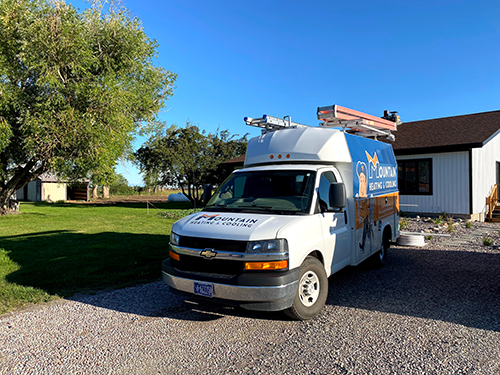
Replacement, Service
Your comfort and safety are our focus 100% of the time. Our COVID in home Technician Procedure is built with you in mind. Here is what we are doing.
COVID prevention all starts at the office
- Daily Staff Temperature Screening/Reporting to office
- We support our team, no team member will be left behind. Paid leave until return.
Onsite COVID In Home Technician Procedure:
The simple procedure of minimizing person-to-person close quarters is our industry-leading best practices response to an awful reality of COVID-19 that we are all currently living with in 2020.
Here’s what to expect when we arrive:
- Your Mountain Heating and Cooling team member will call ahead and confirm your appointment time prior to arriving at your home or business.
- When we arrive we knock or check in at the office, stepping back 6 feet from the door or desk.
- Prior to entering your home or job site we will put on latex gloves, mask and shoe coverings.
We realize you need your home serviced and count it a privilege to serve you. As part of that privilege we have doubled down on our diligence to remove as many risk factors as possible related to the current pandemic challenges of in-home operation.
- We boot up
- We mask up
COVID employee policy
- Employees subjected to known COVID Positive persons must immediately report their exposure.
- Exposed employees are immediately asked to self-quarantine and be tested for the virus.
- Only After employees test negative and are they allowed to return to work
We value your business and safety, along with our teams. Fortunately through care and industry leading practices we are continuing to see rave reviews from customers confident that they are safe in their own home.
We are ready to serve you when you need us most. We look forward to helping our stay safe as we help you make your home more comfortable.
Schedule Your Appointment





